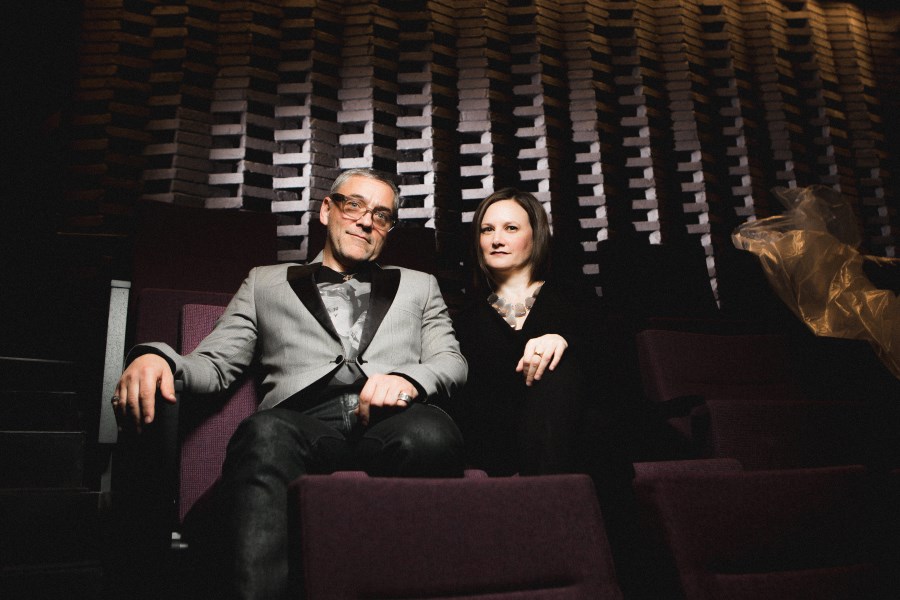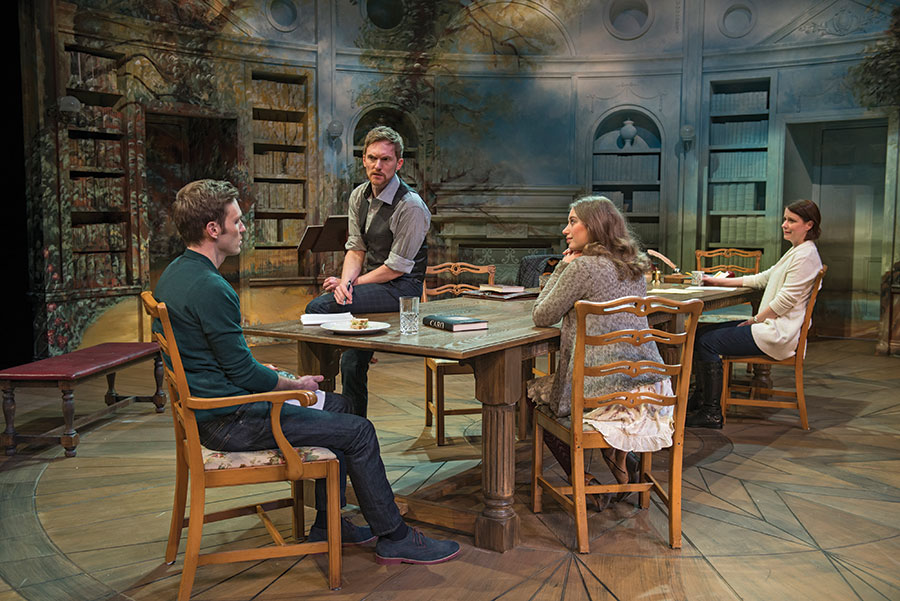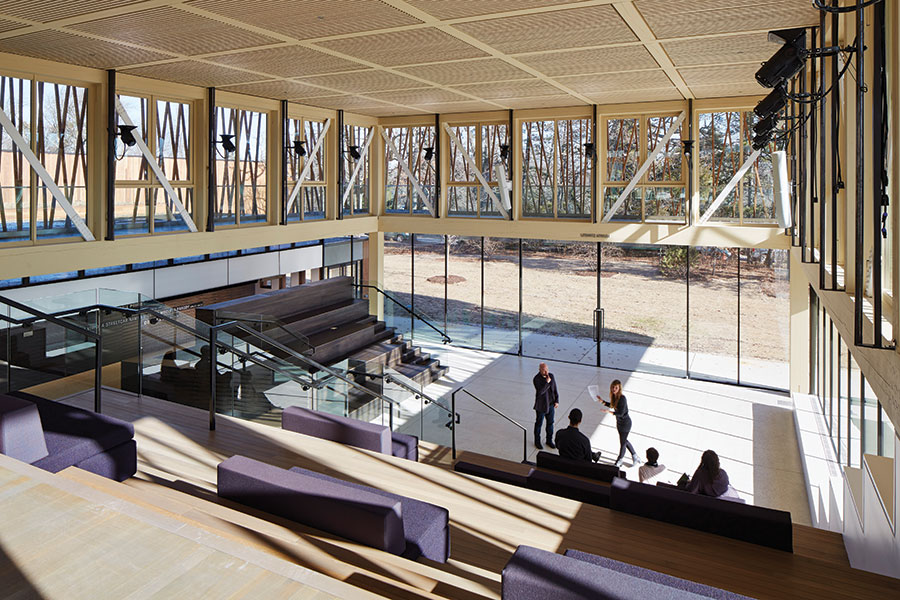Glencoe, Ill., one of a string of affluent towns strung along Lake Michigan north of Chicago, is a quiet place—a village, really, where the brick sidewalks of the business district run but a few blocks before the downtown disappears, giving way to tree-lined residential streets. It’s a pretty sleepy burgh on a weekend afternoon, and back in March, the few folks to be seen walking around the town all seemed headed to the same place: the back room of an unprepossessing bookstore where the artists of Writers Theatre had long worked their stage magic in a space so small that a woman’s handbag laid on the floor might impede an actor’s entrance.
The company has mounted productions at Books on Vernon since its inception in 1992, and what they lacked in space they more than made up for in intimacy and quality. “In a tiny auditorium, the high-wire act of suspension of disbelief is stretched to a thrilling degree,” remarks playwright Conor McPherson, whose Dance of Death and Port Authority have been mounted in the space. “Writers Theatre has never scrimped on any area. In my experience, the actors were very well looked after and respected in every regard, and the design elements, from costume to lighting to props, were second to none.”
In 2003, Writers took off some of the pressure, adding a second venue nearby, a 108-seat space in the Woman’s Library Club of Glencoe. But this spring, at long last, Writers took up residence in a home of its own: an understatedly impressive facility designed by award-winning Chicago architect Jeanne Gang. The theatre has taken care not to leave its past behind. While swank compared to its former digs, with a sleek lobby and a generous concession stand, the new building expresses the soul of the organization in its two performance spaces: a 250-seat thrust stage and a 99-seat flexible black box. In short, the intimacy that has been a hallmark of the company remains central to its identity.
“We’re not interested in creating a space where the audience is dazzled by technical wizardry,” says founding artistic director Michael Halberstam. “You need to be able to go into a theatre and see a play and, rather than coming out and saying, ‘Wow, those costumes were gorgeous—and that set!’ you should come out of it saying, ‘What am I doing with my life?’ or, ‘I have to call my parents’ or, ‘I just learned something about myself; I need to go for a walk.’”

Born in the U.K., Halberstam studied at the University of Illinois and acted in Chicago for a number of years before plunking down $10,000 of his own money to get the company up and running. Its first offering was Love and Lunacy, an adaptation of Chekhov stories that Halberstam directed and cowrote. Halberstam staged most of the company’s shows in the early years and continues to take the helm from time to time, but he never intended to be a one-man band, and has long welcomed an array of talented directors, including Kate Buckley, William Brown, Gary Griffin, and Jessica Thebus.
In 1995, David Cromer directed Halberstam in Oscar Remembered, Maxim Mazumdar’s less-than-lauded one-man show about the friendship of Oscar Wilde and Lord Alfred Douglas. It was early in Cromer’s career, and he was happy for the gig. “Then we did a read-through and we realized that it just wasn’t that good,” he recalls. “For good and ill, we set about reworking the play until it was what we felt was an exciting night in the theatre. The lesson I think Michael and I learned was, never be uncertain about the value of the writing before you agree to anything. I try to live by that and so does he. It’s hubris to think you can fix it, that ‘It’ll be okay if I just unleash my cleverness.’”
That inauspicious beginning didn’t dissuade Cromer from returning to Writers, where he subsequently directed well-received renditions of Picnic and A Streetcar Named Desire. Kimberly Senior, perhaps best known for helming the work of Ayad Akhtar (Disgraced, The Who and the What), has become a Writers regular too, directing Jordan Harrison’s Marjorie Prime and The Diary of Anne Frank in the 2015-16 season alone.
“Michael is really trying to advance the conversation in the American theatre about which stories we are telling, why we are telling them, who is telling them, and who we are telling them for,” Senior says. “He creates a holistic environment for exploration, while demanding artistic excellence and rigor at the same time. It is an incredible blessing as a freelance artist to have a sustained relationship with a theatre, an artistic director, the staff, the artists who work there, and most importantly the audience.”
Passionate about what he does and almost overwhelmingly voluble when discussing his calling, Halberstam says that he sees theatre as “a guided meditation using text and emotion and movement as vehicles by which you are led through an idea, a vision, into the human soul. And right now, I can’t think of anything more important to be doing.”
That conviction has served Writers well over the years, earning the theatre a loyal audience, 26 Joseph Jefferson Awards, and a shout-out from The Wall Street Journal’s Terry Teachout, who called it one of the top theatres in the country. While it has “writers” in its name, though, the organization is not primarily an incubator of new work. Rather, with “valuing text” in its mission statement, Writers’ programming accordingly has included such playwrights as Shakespeare, Shaw, Lucas Hnath, and David Ives. However, the company has premiered several works, including A Minister’s Wife (with music by Josh Schmidt and book by Austin Pendleton) and Evan Smith’s The Savannah Disputation, which went on to have productions in New York City.
Thanks to these successes, Writers found itself in the enviable if urgent position of having to contemplate greater institutionalization.
“Our smaller theatre was inside a bookstore, our 108-seat theatre was in another building, our rehearsal space was inside a church,” notes executive director Kathryn Lipuma, who previously spent nine years in the same role at New York’s Signature Theatre Company. “We needed to find a different home. We needed to control our own destiny.”
Another plus, in terms of continuity: Writers built its new home on the same site of its former second stage, the Woman’s Library Club. Expanding its operations there in 2003 enhanced the organization’s programming and profile, but the 1938 clubhouse was showing its age—beset by falling plaster, overflowing toilets, and general, deep-set decay.
“We had a home there, so we sat down with the club and said, ‘You don’t want to deal with fixing the toilets and everything else that’s broken,’” Lipuma recalls. So they found a way “to make an arrangement where we lease the land and build a new building with our own funds—one that will allow you to continue to have your activities. And if something breaks, we take care of it now.” So the club donated the building to Writers while maintaining ownership of the land. “It was a win-win,” adds Lipuma.
While Writers was off to a good start, thanks to significant early commitments from its board and other supporters, the organization proceeded carefully toward its goal.
“We took our time and we did a lot of research,” recalls Lipuma. “I did not want to build this theatre and have that moment where we say, ‘Oh, we forgot A, B, and C.’ We’ve spent time not just budgeting to get into this space but projecting two, three years out.” What’s more, though the project did not draw from village coffers, for Lipuma, Halberstam, and architect Jeanne Gang, transparency was crucial in maintaining community support.
“From the very beginning we had a lot of what we call ‘town hall meetings,’” says Lipuma. “We sent out emails: ‘We’re having the architect come and do a little Q&A; join us for some coffee and conversation.’ All that was critically important to alleviate any fear, I think, from what could be a very large building going in a very small downtown area.”

Although the company’s new 36,000-square-foot home comprises two performance spaces, a spacious lobby, commodious rehearsal hall, and rooftop patrons’ lounge, Gang has scaled everything to fit between a playground and a grove of trees adjacent to the village’s business district. Orchestrated as a constellation of relatively low-rise volumes that flow directly to the sidewalk, the building expresses, in a very simply limned and distinctly contemporary manner, the kind of civic presence historically manifest in such structures as libraries, post offices, and city halls.
“I did consider the context of the area, and there’s everything there, from Victorian homes and faux-Tudor commercial buildings to modern structures,” says Gang, a past MacArthur Fellow whose current projects include the Gilder Center at the American Museum of Natural History. “I didn’t want to replicate any of that. But in its massing and material, the building feels like it fits in. It doesn’t feel like a shiny, glitzy downtown theatre project.”
The glass curtain wall of the lobby, which can be opened in fair weather, and the exterior, wood-strung gallery that winds around above it, further extend the building into the immediate neighborhood. When populated with ticket holders, these spaces offer passersby a sense of spectacle that echoes the goings-on onstage. “Writers is all about the intimacy between performer and audience,” says Gang. “But they also share an intimacy with the community, and the building reflects that as a kind of public gesture.”
The theatre’s lobby not only supports the ceremony of playgoing in a way the company’s previous venues did not, but its tiers of seating—one of which also functions as a wide stairway—offer the opportunity for yet another performance space within the building.
“We’re talking to small chamber orchestras about the possibility of doing a concert series, and eventually I’d love to see that space become an ecosystem of its own,” says Halberstam. That might include, suggests Lipuma, educational outreach activities or storytelling events. “Maybe some family programming on Saturday mornings, or local schools could do showcases here.”
Not surprisingly, in the months leading up to the opening, fashioning a debut season that reflects the company’s profile while celebrating this new phase of its existence was Halberstam’s primary concern. Where some artistic directors might have opted for an old chestnut or some contemporary hit, he selected Tom Stoppard’s attention-demanding, word-rich Arcadia, which ran March 16-May 1.
“I loathe the idea of going to a theatre and leaning back and relaxing,” states Halberstam. “When I go to the theatre, I want to lean forward and engage. I think there’s a degree of accessibility to Arcadia, in that it’s already a proven commercial product. It’s had two runs on Broadway and one in the West End. It is a challenging piece of theatre, but it seems to have paid off. I’d say 95 percent of the audience has been very, very enthusiastic and the other five percent bewildered; bewildered but mostly game. And we’ll reward them with the next show,” he said, referring to a collaboration between Writers and the Second City: Death of a Streetcar Named Virginia Woolf: A Parody (April 27-July 31).
“It’s a tough season to plan,” admits Lipuma, “because you want to convince the people who have been with you for the last 24 years that you’re still the company they’ve loved and appreciated. At the same time, you want to create work that’s exciting and engaging for new folks who have never been with us before.”
The loyalty of Writers’ constituency is exemplified by the financial commitments made toward the $34 million project—including leading gifts in amounts ranging from $1 to $5 million—and hundreds of smaller contributions from avid audience members. “If you ask what I attribute that early support to,” says Elaine Tinberg, building committee chair and past board president, “it’s because since our inception, we have really reached out to our subscribers and donors over and over and treated them with the value we have for them.”
Like Lipuma, Tinberg feels certain the organization has projected wisely for the future, with funds to cover the first five years operating in the new facility, as well as a $2 million cash reserve to meet unexpected expenses or support new strategic artistic initiatives.
“We did a lot of financial modeling to make sure we could take care of the building and pay our artists and staff at the rate we’d like to pay them,” asserts Tinberg. “I think the challenge for any organization as it grows pretty significantly from one year to the next is making sure that the subscriber base expands too, and we’re off to a really good start.”
Lipuma reports that in the year leading up to the debut of the new building, Writers has gone from 5,800 to 7,550 subscribers. “When you think about it, we started this project at the worst possible time, 2008,” relates Lipuma. “Who is going to give you a million dollar check when the economy is tanking? So that actually provided us some time to be a little more thoughtful and more strategic, making sure that we had everything that we needed to sit down in front of a donor—to say, ‘We’ve thought about the fundraising, we’ve thought about a business plan, we’ve thought beyond just getting into the building.’ So that when someone got to the point where they wanted to make that contribution, they felt secure in what they were doing, they felt secure in our leadership, and what this institution stood for. And it made that gift meaningful for them as much as it was meaningful for us.”
As Writers Theatre rolls through summer—the inaugural season continues with the Stephen Sondheim musical Company, June 15-July 31—Lipuma feels stronger than ever about company’s decision to up its game. “Having this permanent space has enlarged and will continue to enlarge the company’s identity on a national and international level,” she says. “People are thinking about the company in a different way. Even though we’ve always been here, the dialogue has changed.”
While clearly delighted with Writers’ new home and all that it promises, for Halberstam, in some respect it’s all business as usual. “Jeanne Gang not only made an interesting piece of architecture, but actually understood the organization, so that when you walk in, it feels like we’ve always been here,” he says. “You know when you get into a rental car after driving your car for a year or two years straight, and suddenly you’re in something else, and it’s almost like you don’t know how to drive it? That never happened. We just moved right into the rehearsal hall and then we moved right into the theatre. It’s been effortless.”
Thomas Connors is a freelance arts writer based in Chicago.


